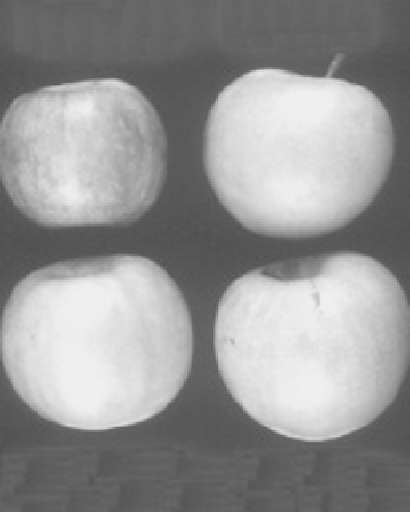Agriculture Reference
In-Depth Information
Control
DPA
12 h, 46
°
C
72 h, 38
°
C
Fig. 11.4
Superficial scald on apple peel is prevented by diphenylamine (DPA) and by hot air heat of 12 h at
46
◦
Cor72hat38
◦
C.
the disorder, and a number of time-temperature regimes have been effective, from 3 days
at 38
◦
Cto12hat46
◦
C (Klein and Lurie, 1992) (Fig. 11.4). Recently there have been
reports of some success with a hot water dip at 48
◦
C (Jemric et al., 2006). Heat treatments
that satisfy quarantine requirements tried on apples also controlled scald, but exacerbated
another disorder, bitter pit (Neven et al., 2000). In addition, trials on a number of cultivars
showed that their response to high temperature differed, with some responding positively
and others developing internal browning (Tu and De Baerdemaeker, 1997). Therefore, it is
important to test the cultivar at different heating regimes and not simply to use what has
been reported for other cultivars.
11.5 Heat treatment in fresh-cut fruits
The use of heat treatment on fresh-cut commodities can be a treatment of the commodity
before processing or a treatment after processing. In the first instance, the purpose would
be to affect ripening or senescence processes so that these processes will be delayed in the
fresh-cut commodity. The reduced shelf life of cut fruit, relative to that of intact fruit, is
associated with physiological and biochemical changes typical of the senescence process
such as increased respiration and ethylene production, and loss of membrane integrity
(Toivonen and DeEll, 2002). The inhibition that a heat treatment confers on whole fruit
can extend to the fruit after cutting. This has been tested in a number of fruits. In melons a
precut heat treatment at 50
◦
C for 60 min reduced the rate of respiration and moisture loss of
the cut fruit, and increased the intensities of fruity and sweet aromatic flavors (Lamikanra
et al., 2005). Apples were also heat treated before slicing. When they were held for 4 days











Search WWH ::

Custom Search